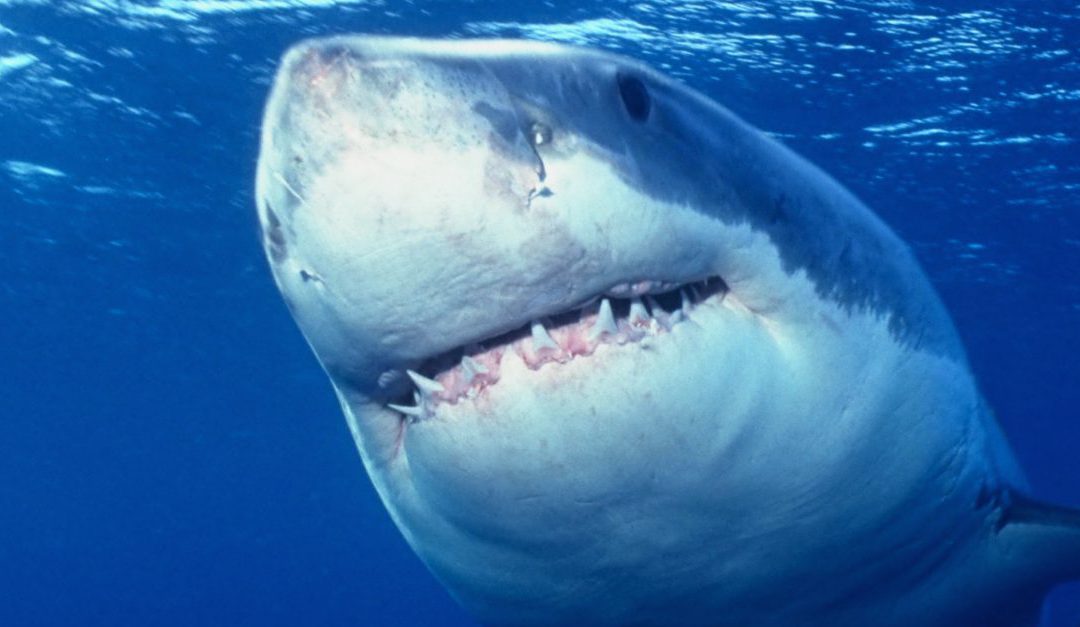
by Laura Tiu | Sep 11, 2020
When one thinks of the Emerald Coast, visions of sparkling water, baby-powder beaches, rental houses and high-rises interwoven with seafood and pizza restaurants appear. The coast is dotted with fishing boats, pirate ships and dolphin cruises and the beaches are littered with people. But it is what glides under the water that some people are curious about. “Are there sharks in the water here?” is a question I often get from locals and tourists alike. The answer is yes, sharks call saltwater home.
Sharks evoke a variety of emotions in people. Some folks are fascinated and list shark fishing and diving with a shark on their bucket lists. Others are terrified, convinced that sharks only exist to hunt them and bite them while they take a swim. Unfortunately for the sharks, their appearance plays into this later fear, with sharp teeth, unblinking eyes and sleek bodies. The reality is that most sharks only grow up to three feet in length and eat small shrimp, crabs and shrimp, not humans. But it is true that bull, tiger and great white sharks are all large species that have been known to attack humans.
Of the 540 different species of sharks in the world, there are about twelve that call the Emerald Coast home including Atlantic sharpnose, bonnet head, blacktip, bull, dusky, great white, hammerhead, nurse, mako, sand, spinner, and tiger. They don’t all stick around all year, with some migrating south in the winter, while others migrate north.
Sharks use their seven senses to interpret their environment: smell, sight, sound, pressure, touch, electroreception, and taste. Most shark attacks occur when a human is mistakenly identified as prey. There are some easy measures you can take to reduce the risk.
- Swim with others, this may intimidate sharks and allows someone to go for help if a bite occurs.
- Remove jewelry as it can look like an attractive shiny fish underwater.
- Don’t swim where folks are fishing as bait in the water may attract sharks.
- Pay attention to any schools of baitfish in the area that may be attracting sharks.
- Do not swim at dusk or dawn when visibility may be poor.
- Learn how to identify various shark species
Remember, shark attacks on humans are rare. Reports of stepping on stingrays, jellyfish stings, lightning, dangerous surf conditions and car accidents greatly outnumber the number of shark attacks every year.
For more information: https://www.floridamuseum.ufl.edu/sharks/education-resources/
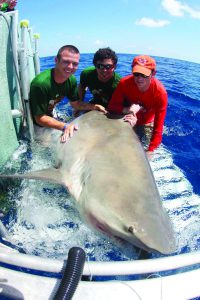
A bull shark being tagged by researchers (credit: Florida Sea Grant).
“An Equal Opportunity Institution”
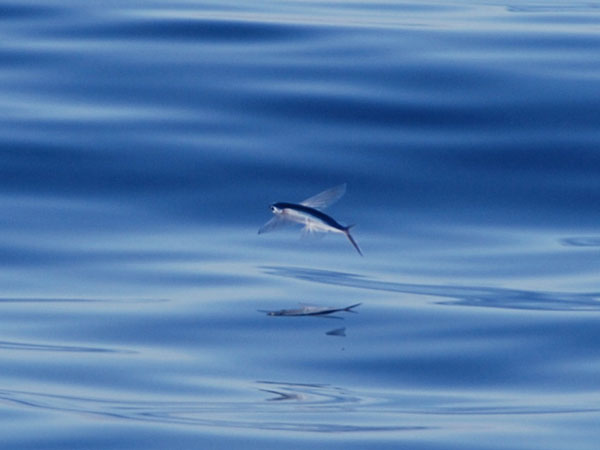
by Rick O'Connor | Sep 11, 2020
There is a lot of blue out there… a whole lot of blue. Miles of open water in the Gulf with nowhere to hide… except amongst yourselves. Their blue colored bodies, aerodynamically shaped like bullets with stiff angular fins, can zip along in this vast blue openness in large schools. Their myoglobin rich red muscle increases their swimming endurance – they can travel thousands of miles without tiring. Some species are what we call “ram-jetters”, fish that basically do not stop swimming – roaming the “big blue” looking for food and avoid being eaten, following the warm currents in search of their breeding grounds.
The open water is a place for specialists. Most of these fish have small, or no scales, to reduce frictional drag. They have a well-developed lateral line system so when a member of the school turns, the others sense it and turn in unison – just as the four planes in the US Navy Blue Angels delta do – perfect motion.
Many are built for speed. Sleek bodies with sharp angular fins and massive amounts of muscle / body mass, some species can reach speeds close to 70 mph – some can “fly”. There are fewer species who can live here, as opposed to the ocean floor, but those who do are amazing – and some of the most prized commercial and recreational fishing targets in the world. Let’s meet a few of them.
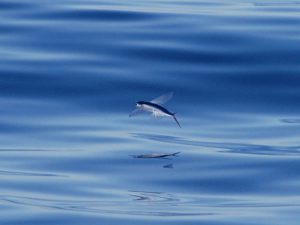
Flying fish do not actually “fly”, they are gliders using their long pectoral fins.
Photo: NOAA
Flying Fish
First, they do not actually fly – they glide. These tube-shaped speedy fish have elongated pectoral fins, reaching half the length of their bodies. The two lobes of their forked tail are not the same length – the lower lobe being longer. Using this like a rudder, they gain speed near the surface and, at some point, leap – extend the large pectoral fins, and glide above the water – sometimes up to 100 yards. As you might guess, this is to avoid the sleek speedy open water predators coming after them. You might also imagine that they, and their close cousins the half-beaks, are popular bait for the bill fishermen seeking those predators.
There are eight species of these amazing fish in the Gulf of Mexico ranging in size from 6-16 inches. Most are oceanic – never coming within 100 miles of the coast, but a few will, and can, be seen even near the pass into Pensacola Bay.
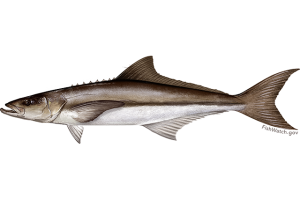
The cobia – also known as the ling, lemonfish, and sergeant fish, is a migratory species moving through our area in the spring.
Image: NOAA
Cobia
This is one of the migrating fish local anglers gear up for every year – the cobia run. When the water turns from 60° to 70°F in the spring – the cobia moves up the coastline heading from east to west. They have many different common names along the Gulf Coast. Ling, Cabio, Lemonfish, and Sergeant fish have all been used for this same animal. This is one reason biologists use scientific names – Rachycentron canadum in this case. That way we all know we are talking about the same fish. Whatever you call it, it is popular with the anglers and there is nothing like a fresh cobia sandwich – try one!
They can get quite large – 5 feet and up to 100 pounds – and resemble sharks in the water, sometimes confused with them. They seem to like drifting flotsam, where potential prey may hangout, and fishermen will toss their baits all around their schools trying to get them to take. At times, fishermen have confused sea turtles with cobia and have accidentally snagged them – only to release it, though it is a workout to do so, and they try to avoid it.
Cobia are in a family all their own. Their closest relatives are the remoras, or sharksuckers, which sometimes attach to them. They travel all over the Gulf and Atlantic Ocean.
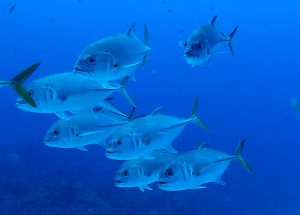
Jacks have the sleek, fast design of the typical open water marine fish.
Photo: NOAA
Jacks
This is the largest open water family of fish I the northern Gulf – with 24 species. Not all jacks are open water, many are found on reefs and in estuaries. But these are aerodynamic shaped fish, with small scales and angular fins, and built for the open water environment. They vary in size, ranging from less than one foot, to over three. This group is identified by the two extended spines just in front of their anal fin. Several species – such as the amberjacks, pompano, and almaco jacks – are prized food fish. Others – like the jack crevalle and the blue runner (hardtail) – are just fun to catch, putting up great fights.
They are schooling fish and often associated with submerged wrecks and reefs, where prey can be found. The black and white pilot fish is called this because mariners would see them swimming in front of sharks – “piloting” them through the ocean. They are open water jacks but are more tropical and accounts in our area are rare.
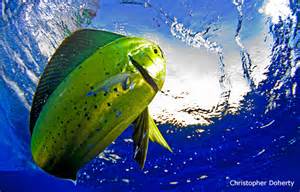
The colors of the mahi-mahi are truly amazing.
Photo: National Wildlife Federation
Mahi–Mahi
This is the Hawaiian term for a fish called the dolphin (Coryphaena hippurus). You can probably guess why they prefer to call it by its Hawaiian name. It is a popular food fish, and to have “dolphin” on the menu – or to say “hey, we’re going dolphin fishing – want to come?” would raise eyebrows – and have.
The Mexicans call it “dorado”, and that term is used locally as well. Either name – it is an amazing fish. With the bull-shaped forehead of the males – they are sometimes referred to as the “bull-dolphin”. Their colors, and color changing, is amazing to see. Some biologists believe this may be some form of communication between members, don’t know, but the brilliant greens, blues, and yellows are amazing to see. They lose these colors shortly after death, so you must see it to believe it – or find one of the popular fish t-shirts.
Like jacks, dolphin like to hang around flotsam, or large schools of baitfish, looking for prey. As with many other open water predators, they will sometimes work in a team to scare, and scatter, individuals from the safety of their school. There are only two species in this family, and both are prized for their taste.

The Striped Mullet.
Image: LSU Extension
Mullet
This is not one you would typically call an “open water” fish. But in the nearshore Gulf and estuaries, they are more open water than bottom dwellers – though they do feed off the bottom. Sleek bodied, forked tail, angular fins, they have what it takes to be a fast swimmer. Though they do not “fly” as the flying fish do, they do leap out of the water. Many visitors hanging out around the Sound will hear a fish splash and immediately ask “what kind of fish was that?” Many locals will respond without looking up – “it was a mullet” – and they are probably right.
This brings up the age-old question… why do mullet jump? This was once asked of a marine biology professor. He paused… thought… and responded saying “for the same reasons manta rays jump”. That was it… another long pause. Finally, the students “took the bait” – “Okay, why do manta rays jump?”. The professor replied, “we don’t know”. So, there you go.
Another interesting thing about this fish is its wide tolerance of salinity. Mullet have been found in freshwater rivers and springs and the hypersaline lagoons of south Texas – they truly don’t care.
Locally they are popular food fish, and support a large commercial fishery in Florida, but in other parts of the Gulf not so much. It has to do with their environment and what they are feeding on. In muddier portions of the Gulf (or our bay for that matter) they have an oily taste and locals there call the “trash fish”. Even hearing that locals here eat them “grosses” them out. Local respond by giving it a more “high end” name – the Mulle (spoken with a French accent). This is actually the Cajun term for the fish. And let’s step it up a notch by adding that many locals eat mullet row – the eggs. Yea… getting hungry right? One of the popular cable food shows came here to try mullet roe. They said on a scale of 1 to 10, they give it a -4.
All that said, it is a local icon – with seafood stores selling “In Mullet We Trust” t-shirts, and the popular “Mullet Toss” event held every year on Perdido Key. It is a COOL fish.
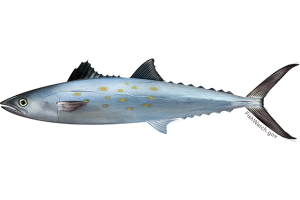
This Spanish Mackerel has the distinct finlets of the mackerel family along the dorsal and ventral side of the body.
Image: NOAA
Mackerel
When you mention mackerel around here you usually think of one of two fish – the king mackerel (sometimes just referred to as “the king”) and the Spanish mackerel. But it is actually a large family of open water fish that includes the tuna, bonito, and the wahoo (of baseball fame).
They are some of the fastest fish in the sea, and several species are ram-jetters. Sleek bodies, sharp angular fins, they can be identified by the row of small finlets on the dorsal and ventral sides of their bodies near the rear. Full of red muscle, rich in myoglobin (which can hold more oxygen than hemoglobin alone), these are powerful swimming fish and very popular in the sushi trade. A bluefin tuna can be 14 feet long, 800 pounds, and bring a commercial fisherman tens of thousands of dollars. Because of this bluefin tuna are internationally protected and managed.
Another cool thing about these guys is that some species can control blood flow, and location, to help maintain a higher body temperature – “warm blooded” – allowing them to venture into colder waters of the world’s oceans. They are one of the big migratory fish we find. Following the large ocean currents, some species use this to play out their entire life cycle. Born in the warmer portions of the ocean gyres, they grow and feed in the cooler areas, returning in the warmer currents to breed.
There are 12 species in this family ranging in size from 1 to 15 feet. They have the characteristic “dark on top – light one bottom” coloration many animals have. This called countershading. It is believed to be used as a form of camouflage in the deep blue – with the darker blue-indigo on top (to blend in with the bottom if look from above) and the lighter silver-white on the bottom (to blend in with the sunlit surface if viewed from the below). This idea was used by the US Navy during World War II. If you visit our Naval Aviation Museum, you will see they painted the planes a darker blue on top and a lighter white on bottom. In hopes that the Japanese pilots would have a hard time spotting them over the Pacific Ocean. It is also believed to help with temperature control. The darker side will absorb heat, while the lighter side releases – avoiding over-heating. Amazing fish, aren’t they?
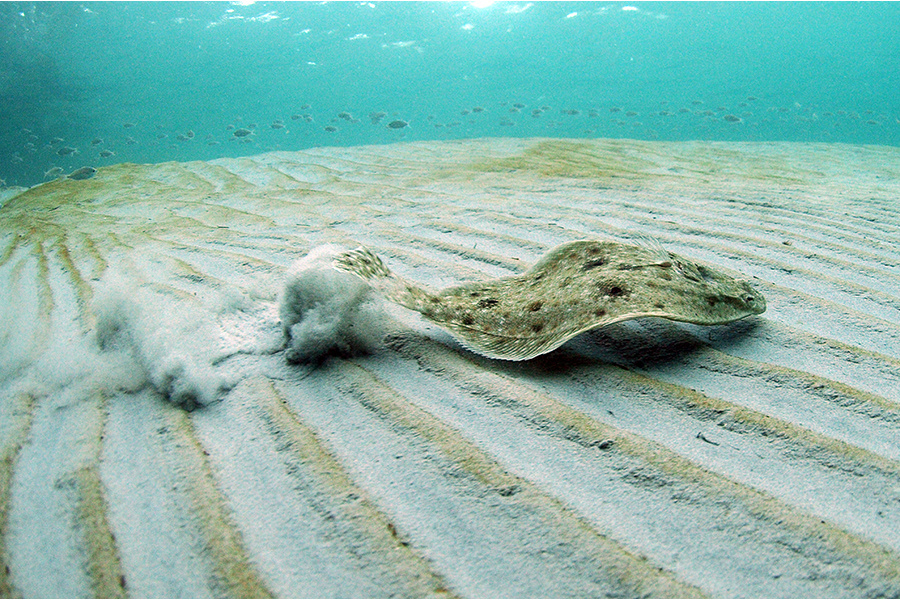
by Rick O'Connor | Sep 3, 2020
We continue our series on estuarine and marine fish and wildlife with fish who live on the bottom.
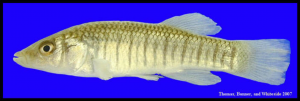
This longnose killifish has the rounded fins of a bottom dwelling fish.
The Gulf of Mexico is a huge ecosystem. With 600,000 m2 and an average depth of 6000 feet, there is a lot of “blue” out there for fish to find a home. But oddly enough, 69% of the species describe in the northern Gulf live on the bottom – what we call benthic fish.
This makes since really. In the “open blue” there are few places to hide from predators and prey. On the other hand, the seafloor has numerous places to hide – so there they are.
Most benthic fish have a general body design for living there. They are generally deep bodied, more rounded – as are their fins. They have a higher percentage of white muscle which makes them very explosive – for a few seconds. This is how they live. Blending in with the bottom, waiting for the prey to get within range and then exploding on it. This white muscle also gives these fish a distinctive taste, different from the red muscle typically found in the open water fish such as tuna.
In this environment, the sense of smell is very good. Many have taste and smell buds extended on fleshy appendages called barbels (the “whiskers” of a catfish). Many will have their mouth on the bottom side of their head for easier eating – though the predators (like the grouper) will still have it directly in front. Many will make short migrations into estuaries for breeding, but long open ocean migrations are not common. There are 342 species of benthic fish in the northern Gulf, let’s look at a few.
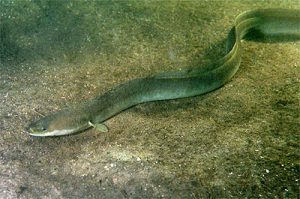
The Anguilla eel, also known as the “American” and “European” eel.
Photo: Wikipedia.
Eels
Something about these animals creeps us out. Maybe their similarity to snakes? Maybe the thought they are electric or venomous – neither of which are true. There are electric eels in the Amazon, but not in the ocean. They do behave much like snakes in that they have very sharp teeth for grabbing prey and can use them on fishermen if they need to. There are 16 species of eels in the northern Gulf. With the exception of the morays – eels live in sandy or muddy bottoms. Shrimpers frequently haul them up, and some are even known as shrimp eels. The American eel (Anguilla rostrata) has a cool life history. They spawn in the middle of the Atlantic Ocean, a place known to the sailors as the Sargasso Sea. It is in the middle of the vortex of ocean currents. The young that catch the northern currents and head to Europe – there they are known as the “European Eel”. Those that catch the southern swirl end up here in the United States are known as the “American Eel”. Their young look like thin pieces of plastic with eyes. Known as elvers they can be found within Pensacola Bay by the thousands when they arrive. The growing adults move up stream and spend part of their lives in our rivers and springs, before swimming back to the Atlantic and starting the process all over. In some areas, there is a commercial fishery for this eel.
Read more:
https://fws.gov/fisheries/freshwater-fish-of-america/american_eel.html.
https://www.fws.gov/fisheries/fishmigration/american_eel.html.
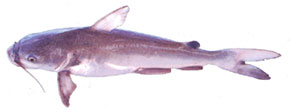
The serrated spines and large barbels of the sea catfish. Image: Louisiana Sea Grant
Catfish
This is a bottom fish that fishermen love to hate. Marine catfish (Ariopsis felis) are oily and not as popular as their freshwater cousins as food. So, when fishermen catch them, they tend to toss them on the beach to die – the idea is that there are fewer to breed – an idea that really does not work – they keep catching them. One interesting twist on this story is that the ghost crabs in the dunes drag the dead ones towards their burrows where they feed on them. The skull of the sea catfish is very hard – giving them their other common name “hardhead” catfish, or “steelhead”. When the crabs are finished the hard skull can be found and the bones on the belly (ventral) side resemble the cross. It is sold in some novelty stores as the “crucifix fish”. To add to the legend, when you shake it, it rattles. This has been described at the “soldiers rolling dice” at the crucifixion. They are actually loose bones. These “crucifix fish” are pretty neat, and pretty common.
The long “whiskers” (barbels) are for finding food buried beneath the sand or mud. It is also believed they may have a form of echolocation to detect prey. As if this were not interesting enough – the males carry the developing eggs within their mouths. Development takes about two weeks and young fish emerge from dad ready for the world.
One other thing the visitor should know – the serrated spine on the dorsal and the pectoral fins can inflict a nasty wound, even releasing a mild toxin. Most discover this when they step on a dead one tossed on the beach, or trying to get one off their hook – be careful of this.
Read more:
https://en.wikipedia.org/wiki/Hardhead_catfish.
http://gcrl.usm.edu/public/fish/hardhead.catfish.php.
https://www.floridamemory.com/items/show/269847.
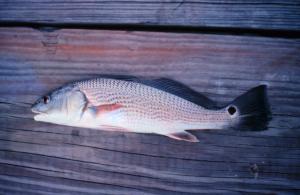
The classic look of a bottom fish. This is the redfish, or red drum.
Photo: NOAA
Drum–Croaker
This is the largest family of estuarine fish in the northern Gulf of Mexico – with 18 species described. The whiting, drum, kingfish, croakers, trout, some perch, and others all belong to this group. They are popular with fishermen and seafood consumers. The red drum (redfish) is one of the more popular targets in our area. Speckled trout (or spotted seatrout) are also a favorite. Most have the characteristic body of a benthic fish. Deep bodied, rounded fins, mouth on the belly (ventral) side. Sea trout have two large “Dracula” looking fangs for grabbing shrimp and other prey. In most, one has broken off and the angler usually finds only one fang present. Some species, such as the black drum, will have short “whiskers” on their chins – you guessed it, barbels – and they are used for finding “buried treasure” (food).
Their common name drum (or croaker) comes from the sounds they produce using their swim bladders. Swim bladders are large sacs within many fish they can fill with gas and float off the bottom. The drum-croaker group rub this with internal muscles making resonating sounds that sound like they are “croaking”. Atlantic bottlenose dolphin can hear this too – and croakers make up a big part of their diet.
Read more:
http://gcrl.usm.edu/public/fish/red.drum.php.
http://gcrl.usm.edu/public/fish/spotted.seatrout.php.
http://gcrl.usm.edu/public/fish/southern.kingfish.php
http://gcrl.usm.edu/public/fish/sand.seatrout.php
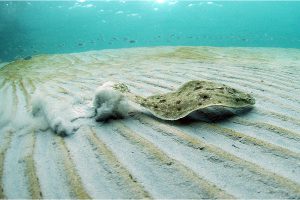
A flounder scurrying across the seafloor.
Photo: NOAA
Flounder
There are actually two types of flatfish in the Gulf – the flounder and the sole. How do you tell them apart?
Well, they are born as a typical-normal looking fish, but as they grow one eye begins to “slide” across the top of the head to the other side – both eyes are now on one side of the head – weird right?
In our part of the Gulf, if the eyes slide to the left side – we call it a flounder, to the right – a sole. There are a FEW exceptions to this rule – but many call the popular flounder the “left-eyed flounder” as opposed to the “right-eyed” one.
So why do they do this?
If your eyes were placed on each side of a torpedo pointed head, you would have what we call monocular vision. This type of vision gives you ALMOST 360° range of view… almost. So even though you can see what is behind you while facing forward, you do not have good depth perception – so you are not sure exactly how far away it is. You must either rely on other senses to help you out or get lucky. Having both eyes on one side (or in front like us) you have binocular vision. You cannot see behind you, but you can tell the distance of the object in front of you. This is common for predator fish like flounder. Many would agree that your mother has both!
With the eyes on one side of the head, they lose color on the other and then lay flat on one side. They can bury in sand and wait for prey. Most species have chromatophores in their skin. These are cells that allow them to change color, like a chameleon or octopus. So, they can change their color to blend into whatever bottom type they are on. What an incredible adaptation.
There are 17 species of flounder, and they are not easy to tell apart – so just call them flounder.
Read more:
http://gcrl.usm.edu/public/fish/flounder.php.
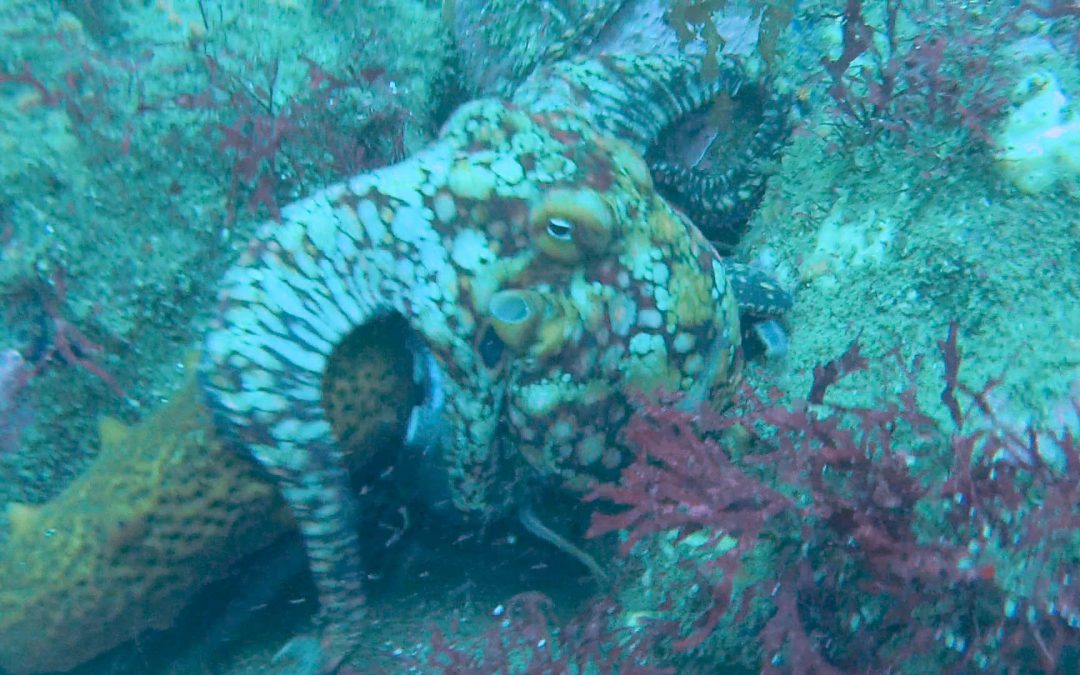
by Rick O'Connor | Jul 7, 2020
For many of the blogs we have posted on marine life of the Gulf of Mexico I have used the term “amazing” – but these cephalopods are truly amazing. There have been numerous nature programs featuring not just marine invertebrates but rather highlighting the cephalopods specifically. We have been amazed by their looks, their colors, their intelligence, and their ferocity. They are the animals of ancient mariner legends – the “kraken”.
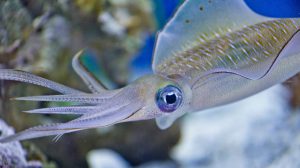
These are not your typical mollusk. The elongated body and lack of external shell changes everything for cephalopods.
Photo: California Sea Grant
But for us who just visit the beach to play and walk – we rarely see them. They are quite common. The squid are almost transparent in the water column as they swim and usually run deep until nighttime. The only ones I have ever encountered were hauled up in shrimp trawls – but they are usually hauled up each time, and sometimes in great numbers. Octopus are more nighttime roamers as well. I have occasionally seen them diving during daylight hours, but they are very secretive and well camouflaged. I have found cephalopods both in the Gulf and within the estuaries – again, they are more common than we think.
A study conducted in the 1950s logged 42 species within the Gulf of Mexico. Many of them live in the open sea and at depths of 350-500 feet. There are actually four types of cephalopods – the octopus and squid we know, the cuttlefish and nautilus less so because they are not common in the Gulf region.
They are mollusk but differ from their snail and clam cousins in that they have very little, if any shell. The nautilus is an ancient member of this group and still possess an external shell. However, it is chambered and can be filled with gas like a hot air balloon allowing the nautilus to hover off the seafloor – something their snail/clam cousins can only dream about.
The squid and cuttlefish have reduced their shell to a surfboard looking structure that is found internally, serving almost like backbone. It allows them some rigidity in the water column, and they can grow to greater size. Actually, the squid are the largest invertebrates on the planet, with the “giant squid” (Architeuthus) reaching lengths of 50 feet or more.
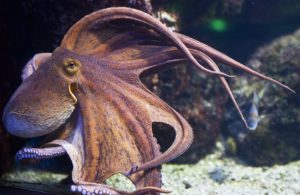
The octopus differs from the squid in that it lacks a shell all together. Thus, it is smaller and lives on the ocean floor.
Photo: University of South Florida
The octopus lack a shell all together. Without this rigid bone within, they cannot reach the great size of the giant squid – so giant octopus are legend. However, there is a large one that grows in the Pacific that has reached lengths of 30 feet and over 500 pounds – big enough!
The lack of a shell means they must defend themselves in other ways. One is speed. With no heavy shell holding you down, high speed can be achieved. Again, squid are some of the fastest invertebrates in the ocean – being clocked at 16 mph. This may not outrun some of the faster fish and marine mammals, and many fall victim to them. Birds are known to dive down and eat large numbers of them. But they can counter this by having chromatophores. These are cells within the skin filled with colored pigments that they can control using muscles. This allows them to change color and hide. And their ability to change color is unmatched in the animal kingdom. I recommend you find some video online of the color change (particularly of the cuttlefish) and you will be amazed. Yes… amazed.
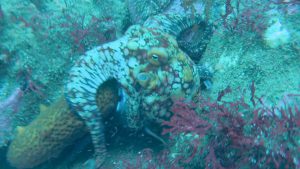
The chromatophores allow the cephalopods to change colors and patterns to blend in.
Photo: California Sea Grant
To control such color, they must have a more developed brain than their snail/clam cousins – and they do. The large brain encircles their esophagus and not only be used to ascertain the colors of the environment (and how to blend in) but also has the capability of learning and memory. The octopus in particular has been able to solves some basic problems – to escape, or get food from a closed jar, for example. Many of these chromatophores possess iridocytes – cells that act has mirrors and enhance the colors – again, amazing to watch.
All cephalopods are carnivorous and hunt their prey using their well-developed vision. Squid prefer fish and pelagic shrimp. Octopus are inclined to grab crustaceans and other mollusk – though they will grab a fish when the opportunity presents itself. Cephalopods hunt with their tentacles – which are at the “head end” of the body. The squid possess eight smaller arms and two longer tentacles. Each have a series of sucker cups and hooks to grab the prey. They keep their tentacles close to their bodies and, when within range, quickly extend them grabbing the fish and bringing back to the mouth where a sharp parrot-like beak is found. They bite chunks of flesh off and some have seen them bite the head off a mackerel. I was bitten on the hand by a squid once – one of the more painful bites I have ever had.
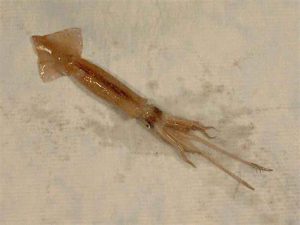
The extended tentacles of this squid can be seen in this image.
Photo: NOAA
The octopus does not have the two long tentacles – rather only the eight arms (hence its name). They move with stealth and camouflage (thanks to the chromatophores) sneaking up on their prey – or lying in wait for it to come close. Here things change a bit. Octopus possess a neurotoxin similar to the one found in puffer fish. They can bite the crab – inject the venom – which includes digestive enzymes similar to rattlesnakes and spiders – and ingest the body of the semi-digested prey after it dies. They can drill holes into mollusk shells and inject the venom within. Most will give a painful bite but there is one in the Indo-Pacific (the blue-ringed octopus) whose venom is potent enough to kill humans.
Making new octopus and squids involves the production of eggs. The male will deposit a sac of sperm called a spermatophore into the body of the female. She will then fertilize her eggs and excrete them in finger like projections that do not have hard shells. Squid usually die afterwards. Octopus will remain with the eggs – oxygenating and protecting them until they hatch. At which time they will die.

Though we have a variety of cephalopods near shore – the real grandeur is offshore. Out there are numerous species of bioluminescent cephalopods – most living at 500 feet during the day and coming within 300 feet at night. Many swim, while some float, others have developed a type of buoyant case they can carry their eggs in. Far too much to go into in a blog such as this one. I recommend you do a little searching and learn more about these amazing animals.
Enjoy the Gulf!
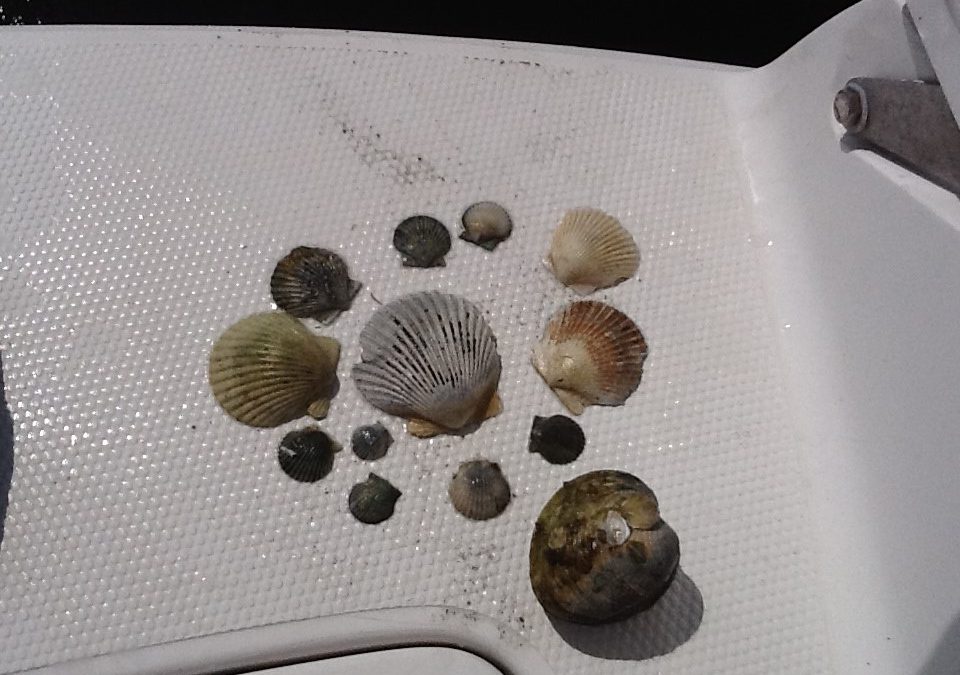
by Rick O'Connor | Jun 26, 2020
This is a good name for this group. They are mollusk that have two shells. They tried “univalve” with the snails and slugs, but that never caught on – gastropods it is for them. The bivalves are an interesting, and successful, group. They have taken the shell for protection idea to the limit – they are COMPLETELY covered with shell. No predators… no way. But they do have predators – we will talk more on that.
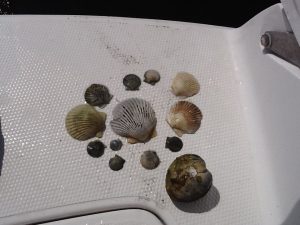
An assortment of bivalves, mostly bay scallop.
Photo: Florida Department of Environmental Protection.
As you might expect, with the increase in shell there is a decrease in locomotion – as a matter of fact, many species do not move at all (they are sessile). But in a sense, they do not care. They are completely covered and protected. Again, we will talk more about how well that works.
The two shells (valves) are connected on the dorsal side of the animal and hinged together by a ligament. Their bodies are laterally compressed to fit into a shell that is aerodynamic for burrowing through soft muds and sands. Their “heads” are greatly reduced (even missing in some) but they do have a sensory system. Along the edge of the mantle chemoreceptive cells (smell and taste) can be found and many have small ocelli, which can detect light. The scallops take it a step further by having actually eyes – but they do live on the surface and they do move around – so they are needed.
The shells are hinged together at the umbo with “teeth like structures and the shells open and close using a pair of adductor muscles. Many shells found on the beach will have “scars” which are the point of contact for these muscles. They range is size from the small seed clams (2mm – 0.08”) to the giant clam of the Indo-Pacific (1m – 3.4 ft) and 2500 lbs.! Most Gulf bivalves are more modest in size.
Being slow burrowing benthic animals, sand and mud can become a problem when feeding and breathing. In response, many bivalves have developed modified gills to help remove this debris, and many actually remove organic particles using it as a source of food. Many others will fuse their mantle to the shell not allowing sediment to enter. But some still does and, if not removed, will be covered by a layer of nacreous material forming pearls. All bivalves can produce pearls. Only those with large amounts of nacreous material produce commercially valuable ones.
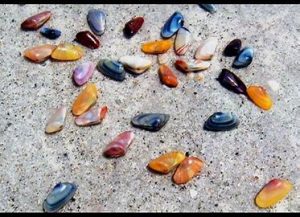
Coquina are a common burrowing clam found along our beaches.
Photo: Flickr
Another feature is the large foot, used for digging a burrowing in the more primitive forms. It is the foot we eat when we eat clams. They can turn their bodies towards the substrate, begin digging with their foot but also using their excurrent from breathing to form a sort of jet to help move and loosen the sand as they go – very similar to the way we set pilings for piers and bridges today.
These are the earliest forms of bivalves – the burrowers. Most are known as clams and most live where the sediment is soft. Located near their foot is a sense organ called a statocyst that lets them know their orientation in the environment. Most have their mantles fused to their shells so sand cannot enter the empty spaces in the body. To channel water to the gills, they have developed tubes called siphons which act as snorkels. Most burrow only a few inches, some burrow very deep and they are even more streamlined and elongated.
Some have evolved to burrow into harder material such as coral or wood. One of the more common ones is an animal called a shipworm. Called this by mariners because of the tunnels they dig throughout the hulls of wooden ships, they are not worms but a type of clam that have learned to burrow through the wood consuming the sawdust of their actions. They have very reduced shells and a very long foot.
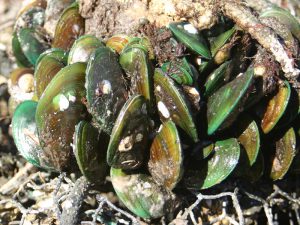
This cluster of green mussels occupies space that could be occupied by bivavles like osyters.
Other bivalves secrete a fibrous thread from their foot that is used to grab, hold, and sometimes pull the animal along. These are called byssal threads. Many will secrete hundreds of these, allow them to “tan” or dry, reduce their foot, and now are attached by these threads. The most famous of this group are the mussels. Mussels are a popular seafood product and are grown commercial having them attach to ropes hanging in the water.
Another method of attachment is to literally cement your self to the bottom. Those bivalves who do this will usually lay on their side when they first settle out from their larval stage and attach using a fluid produced by the animal. This fluid eventually cements them to the bottom and the shell attached is usually longer than the other side, which is facing the environment. The most famous of these are the oysters. Oysters basically have lost both their “head” and the foot found in other bivalves. These sessile bivalves are very dependent on tides and currents to help clear waste and mud from their bodies.
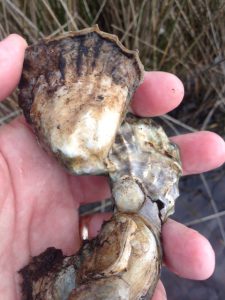
Oysters are a VERY popular seafood product along the Gulf coast.
Photo: Rick O’Connor
Then there are the bivalves who actually live on the bottom – not attached – and are able to move, or even swim. Most of these have well developed tentacles and ocelli to detect danger in the environment and some, like the scallops, can actually “clap their shells together” to create a jet current and swim. This is usually done when they detect danger, such as a starfish, and they have been known to swim up to three feet. Some will use this jet as a means of digging a depression in the sand they can settle in. In this group, the adductor has been reduced from two (the number usually found in bivalves) to one, and the foot is completely gone.
As you might guess, reproduction is external in this group. Most have male and female members but some species (such as scallops and shipworms) are hermaphroditic. The gametes are released externally at the same time in an event called a mass spawning. To trigger when this should happen, the bivalves pay attention to water temperature, tides, and pheromones released by the opposite sex or by the release of the gametes themselves.
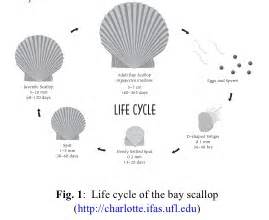
Scallop life cycle.
Image: University of Florida IFAS
The fertilized eggs quickly develop into a planktonic larva known as a veliger. This veliger is ciliated and can swim with the current to find a suitable settling spot. Some species have long lived veliger stages. Oysters are such and the dispersal of their veliger can travel as far as 800 miles! Once the larval stage ends, they settle as “spat” (baby shelled bivalves) on the substrate and begin their lives. Some species (such as scallop) only live for a year or two. Others can live up to 10 years.
As a group, bivalves are filter feeders, filtering organic particles and phytoplankton as small as 1 micron (1/1,000,000-m… VERY small). In doing this they do an excellent job of increasing water clarity which benefits many other creatures in the community. As a matter of fact, many could not survive without this “eco-service” and the loss of bivalves has triggered the loss of both habitat and species in the Gulf region. Restoration efforts (particularly with oysters) is as much for the enhancement of the environment and diversity as it is for the commercial value of the oyster.
Now… predators… yes, they have many. Though they have completely covered their bodies with shell, there are many animals that have learned to “get in there”. Starfish and octopus are famous for their abilities to open tightly closed shells. Rays, some fish, and some turtles and birds have modified teeth (or bills) to crush the shell or cut the adductor muscle. Sea otters have learned the trick to crush them with rocks and some local shorebirds will drop them on roads and cars trying to access them. And then there are humans. We steam them to open the shell and cut their adductor muscle to reach the sweet meat inside.

It is a fascinating group – and a commercial valuable one as well. Lots of bivalves are consumed in some form or fashion worldwide. Take some time at the beach to collect their shells as enjoy the great diversity and design within this group. EMBRACE THE GULF!
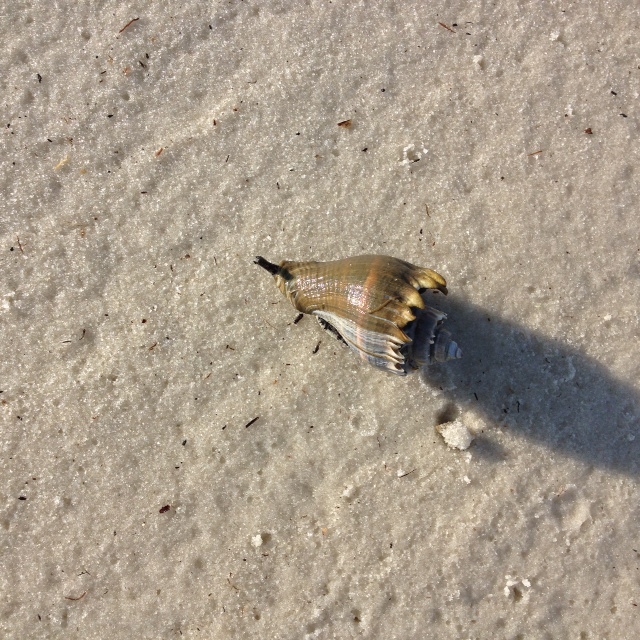
by Rick O'Connor | Jun 11, 2020
One of the largest groups of invertebrates in the Gulf are the Mollusk… what many call “seashells”. Shell collecting has been popular for centuries and, in times past, there were large shows where shells from around the world were traded. Almost everyone who visits the beach is attracted to, and must take home, a seashell to remind them of the peace beaches give us. Many are absolutely beautiful, and you wonder how such small simple creatures can create such beauty.
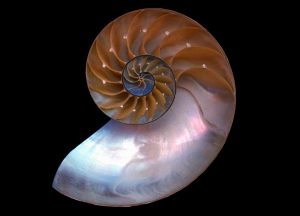
One of the more beautiful shells from the sea – the nautilus.
Photo: Wikipedia
Well, first – not all mollusk are small. There are cephalopods that rival the size of some sharks and even whales.
Second, many are not that simple either. Some cephalopods are quite intelligent and have shown they can solve problems to reach their food.
But beautiful they are, and the colors and shapes are controlled by their DNA. Just amazing.
There are possibly as many as 150,000 different species of mollusks. These species are divided into 8-9 classes (depending which book you read) but for this series on Embracing the Gulf we will focus on only three. First up – the snails (Class Gastropoda).
There are an estimated 60,000 – 80,000 species of gastropods, second only to the insects. They are typically called snails and slugs and are different in that they produce a single coiled shell. The shell is made of calcium carbonate (limestone) and is excreted from tissue called the mantle. It covers their body and continues to grow as they do. The shell coils around a linear piece of shell called the columella. Most coil to the right, but some to the left – sort of like right and left-handed people. There is an opening in the shell where the snail can extend much of its body – this is called the aperture – and some species can close this off with a bony plate called an operculum when they are inside. Some snail shells have a thin extension near the head that protects the siphon – a tube that acts like a snorkel drawing water in and out of the body.
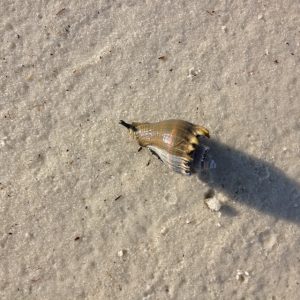
The black siphon can be seen in this crown conch crawling across the sand.
Photo: Franklin County Extension.
They have pretty good eyes and excellent sense of smell. They possess antenna, which can be tactile or sense chemicals in the water (smelling) to help provide information to a simple brain.
They are slow – everyone knowns this – but they really don’t care. Their thick calcium carbonate shells protect them from most predators in the sea… but not all.
Their cousins the slugs either lack the shell completely, or they have a remnant of it internally. You would think “what is the point of an internal shell?” – good question. But the slugs have another defense – they are poisonous. Venomous and poisonous are two different things. Being poisonous means you have a form of toxin within your body tissue. If a predator eats you – they will get very sick, maybe die. But you die as well, so… Not too worry, poisonous slugs are brightly colored – a universally understood signal to all predators.
There is one venomous snail – the cone snail, of which we have about five species in the Gulf. They possess a stylet at the tip of their siphon (similar to the worms we have been writing about) which they can use as a dart for prey such as fish. Many gastropods are carnivores, but some are herbivores, and some are scavengers.
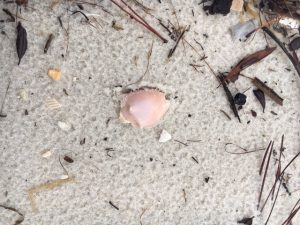
Many shells are found on the beach as fragments. Here you see the fragment of a Florida Fighting Conch.
Photo: Rick O’Connor
Most have separate sexes and exchange gametes in a sack called a spermatophore. Fertilized eggs are often encased in structures that resemble clusters, or chains, of plastic. These are deposited on the seafloor and the young are born with their shell ready for life.
This group is not as popular as a food item as other mollusk but there are some. The Queen Conch is probably of the most famous of the edible snails, and escargot are typically land snails. I am not aware of any edible slugs… and that is good thing.
Some of the more common snails you will find along our portion of the Gulf of Mexico are:
Crown Conch Olive Murex Banded Tulip
Whelks Cowries Bonnets Cerith
Slippers Moon Oyster Drills Bubble
The most encountered slug is the sea hare.
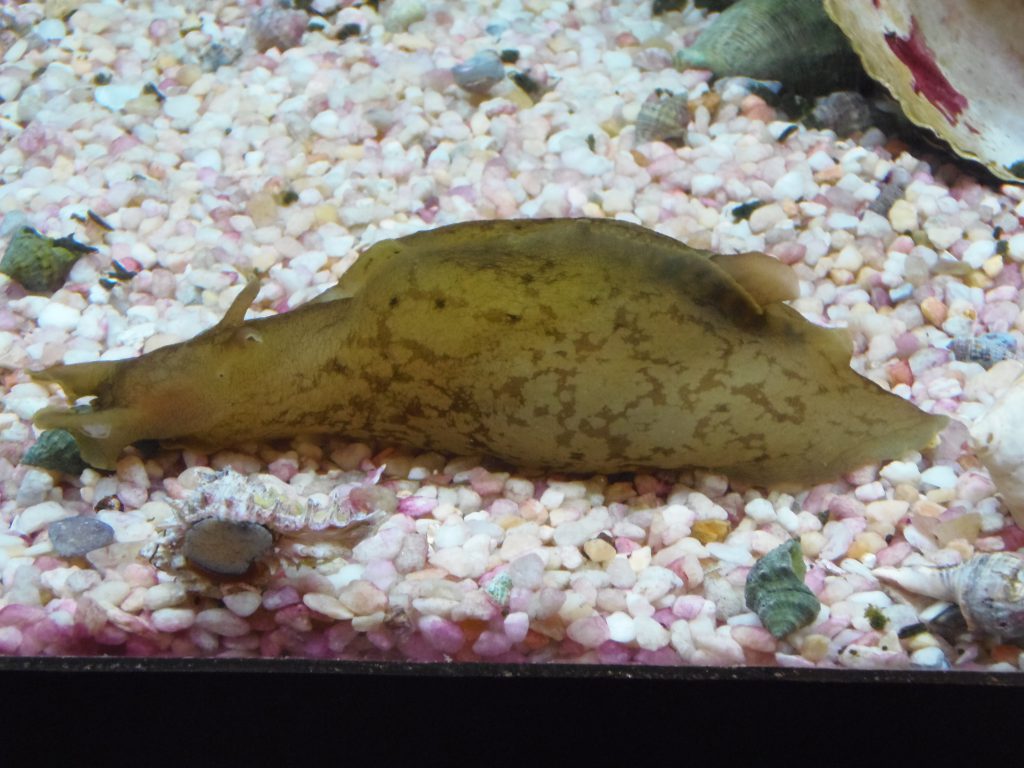
A common sea slug found along panhandle beaches – the sea hare.
I hope you get a chance to do some shelling – I hope you find some complete ones. It is addictive!
































